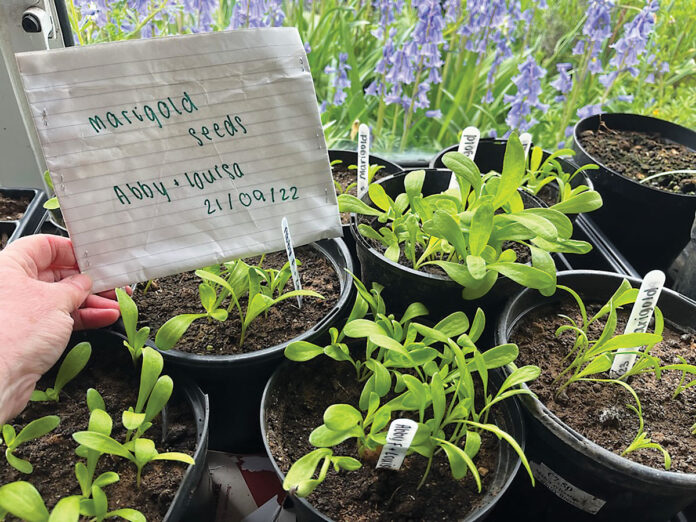It feels good to give back your skills and knowledge to the next generation. It’s a powerful thing to see a bunch of teenagers relish being outside, laughing with classmates as they dig soil to plant potatoes.
I’ve been a Dublin-based garden designer for the last 15 years, and more recently, I’ve become a full member of the Garden and Landscape Designers Association (GLDA). As such, I teach horticulture to transition year (TY) classes in three Dublin schools. (TY – the fourth year of secondary school – is sandwiched between third year, when students do their Junior Cert, and fifth year, when they launch into studying for their Leaving Cert, which they sit sixth year.)
Some see TY as a doss year; but schools generally have great programmes, designed to enable students to try out different areas of interest – including work experience and charity work – and to encourage the students, aged 15 and 16, along paths towards ‘finding themselves’.
The three schools I teach in have horticulture as one of their TY subjects. One school has a dedicated group of 18 students who choose the horticulture module, and they do a weekly hour-long class with me across the school year. The other two schools get everyone in the Year to do horticulture, so I have a different group of 25 students every five weeks.
There are interesting differences between the two ways of conducting my classes. The kids who have the weekly class for the whole school year get to see the full cycle of nature – the abundance in September, the long autumn leading into winter and the raining chilly weather, then the springtime and sowing seeds and watching the soil warm up, and then the abundance again in May before they break for the summer holidays at the end of that month. These kids get really get stuck in; but it is also very beneficial for schools to provide a system that enables every pupil in the school to have a go at gardening.
WHAT THE STUDENTS ACTUALLY DO
The first week I have a new class, I walk the students around the school grounds, pointing out evergreen trees and deciduous trees. We talk about losing foliage, sun getting through heavy canopies, birds nesting and the extra life under deciduous trees that you don’t see under the evergreens.
Then I move to the compost bins. The kids all stand back gasping and looking on in horror when I take out a handful of compost. It always cracks me up when I scrunch up the compost and give them each a small handful and they generally let out a scream. Yes! They can’t believe that I touch this dirt with my bare hands, and then I’m putting it into their hands! But there is always one ‘brave’ kid, who will take the soil into their hands and look at it closely. Then others follow, until more and more are handling the compost.
Before you know it we are talking about the huge significance of soil, and how important it is not to call it dirt or muck, which are derogatory terms. We discuss how everything we eat comes from soil, and the part soil plays in animal-feed production to produce the meat we eat. We talk about how the soil feels, how it smells, the colour of it, the worms wriggling around in it. We talk about the air soil needs for plants’ roots to grow through it, and the microorganisms in the soil for those worms to eat, and how worm poo feeds the microorganisms to feed the plants’ roots, and how the worms are important as bird food.
Next thing, the students are taking selfies with the worms. Their fancy shellac nails are forgotten about as their curiosity gets the better of them; plus no one wants to stand out of the crowd by not taking part in the worm photo shoot.
GETTING DOWN TO WORK
We get to work sowing seeds, potting them on, taking softwood cuttings, digging holes, planting shrubs and trees, planting potatoes and spring bulbs and so on. We leave dandelions and daisies growing in the grass, and convince the groundsmen to mow pathways through the grass rather than just blanket mowing everything.
In the cold winter months when it’s too wet to go outside, I get the students making bird feeders out of old tetra-pack milk cartons, re-using plastic waste, turning it into something useful and beautiful. They keep the feeders topped up with bird food, but it’s usually the seagulls and crows who dive-bomb them rather than the small garden birds eating the food.
The students are creating gardens and learning about nature, climate change issues, biodiversity and pollinators without really realising it. It’s good fun and I get so much craic out of the kids, as I am continuously learning from them too. It’s a lovely exchange of energy and can be especially rewarding when you watch a kid from Ukraine who has been silent for six months suddenly belly-laughing with her classmates over making an Easter wreath, with them all being girly funny teenagers together.
CAREERS
I tell my students that there are tons of careers in the horticulture area, like landscape architecture, garden design, arborism, tree surgery, landscape contracting, craft gardening, ecology, botany, environmental science and much more. The students tell me they never knew about ‘nature’ careers. The Leaving Cert points race concentrates on law, business, medicine, architecture etc. But I say that even if they become engineers, because they have done this class they’ll keep nature and the environment at the top of their agendas when working on new building projects, or making public policy, or doing the legals, or working for a local authority, or whatever other area they work in.
These TY students will be interested in natural remedies, and will prescribe walks and other nature-based activities to patients when they become our future doctors and healthcare professionals. And when they move into their own homes, they will know how to grow their own food and flowers rather than just buying everything. I am hoping these students will become more connected to and learn a deep respect for nature.
FALLING IN LOVE
I guess what I am doing with my TY horticulture classes is encouraging my 16-year-old students to fall back in love with nature, by giving them the opportunity and permission to do so. I always dedicate one class to the kids sitting in the long grass. It’s so lovely seeing them making daisy chains, blowing dandelion clocks and pulling at branches of a huge cherry blossom tree, making pink confetti all over the school garden. They always say afterwards, “I haven’t done that since I was a kid.”
In junior school, children have a nature table in the classroom; they do nature activities regularly, such as tree rubbings, and sowing sunflower seeds. But at the ripe old age of 12, when kids enter the secondary school system, all that nature fun is gone. The pressure on our teenagers is immense, with exams, social media and hormones. The National Green Flag system in primary schools is a fantastic way to ensure buy-in from children and from teachers.
But in the senior school years, the link to nature and horticulture is seen as lame, and something that’s for the ‘disruptive’ or neurodivergent kids to do to burn off a bit of energy. This attitude in my opinion diminishes horticulture into a second class industry. Nature is not celebrated for teenagers, so it’s seen as something childlike and uncool.
That kind of thinking does our industry no favours. I’ve heard it said that the degree course in landscape architecture attracts students who failed to get into architecture, and that horticulture is for kids who like being outside, are not academic and didn’t get into agricultural college. Those attitudes are so damaging to the growth of our industry in attracting young people to train and learn. My hope is that my work with TY is going some way to flipping that narrative.
A BIGGER PICTURE
One of the core principles of the GLDA is to nurture garden design, horticulture students and young designers. We hold an annual student design competition within all the third level colleges on the island of Ireland. We offer a student membership which has a lower fee than the friend membership, with all the same benefits. We visit colleges on career days; mentor the upcoming pre-registered applicants into the full membership process; and we meet the young Bloom Show garden designers.
There is a noticeable uptake in the GLDA pre-reg process over the last few years, and we’re seeing new members increase every year. This invigorates the organisation and builds towards securing the future of excellence in garden design in Ireland.
We all need our young people to care about nature. We are leaving planet Earth to them and their children. The place needs some serious TLC. Those of us lucky enough to work in this amazing industry should do everything we can to pass on our own passion for the planet.
 Marion Keogh is a Dublin-based garden designer. She formed Green Edge with Róisín de Buitléar and Esther Gerrard in 2014 as a co-creative collaborative social enterprise. They organise events and design outdoor transformative spaces with communities and nature in mind. www.marionkeoghgardendesign.com
Marion Keogh is a Dublin-based garden designer. She formed Green Edge with Róisín de Buitléar and Esther Gerrard in 2014 as a co-creative collaborative social enterprise. They organise events and design outdoor transformative spaces with communities and nature in mind. www.marionkeoghgardendesign.com







